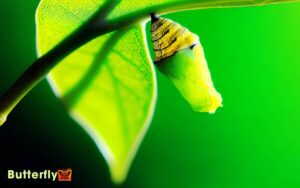How to Identify the Black and Blue Swallowtail Butterfly
The Swallowtail Black and Blue Butterfly, distinguished by its large wingspan and vibrant black and blue coloration, thrives across various ecosystems including rainforests, woodlands, and meadows. These butterflies exhibit complex life cycles from egg to adult, showcasing intricate adaptations for survival and reproduction.
Their feeding extends to nectar-rich flowers, which they pollinate, thereby contributing considerably to ecosystem balance. Seasonal migratory patterns reflect sophisticated adaptive responses to climatic changes, a demonstration of their evolutionary success.
Conservation efforts focusing on habitat preservation and climate impact mitigation are vital for their continued ecological role. Discover more about their intriguing biology and importance.
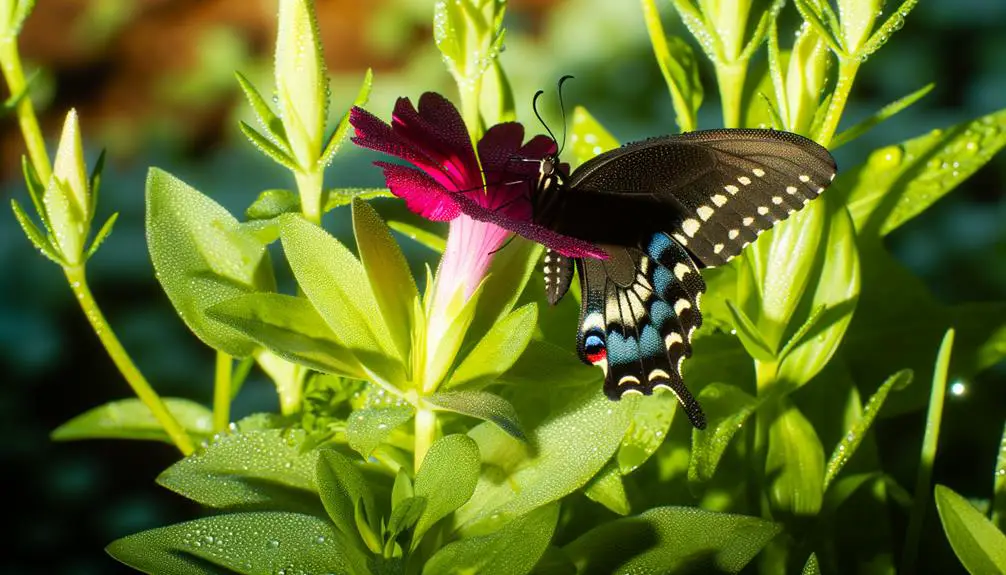
Key Takeaways
- Large butterflies with vibrant black, blue, and yellow wing patterns.
- Found in tropical and temperate regions across multiple continents.
- Undergo complete metamorphosis: egg, larva, pupa, and adult stages.
- Primarily feed on nectar from flowers like milkweed and thistles.
Physical Characteristics
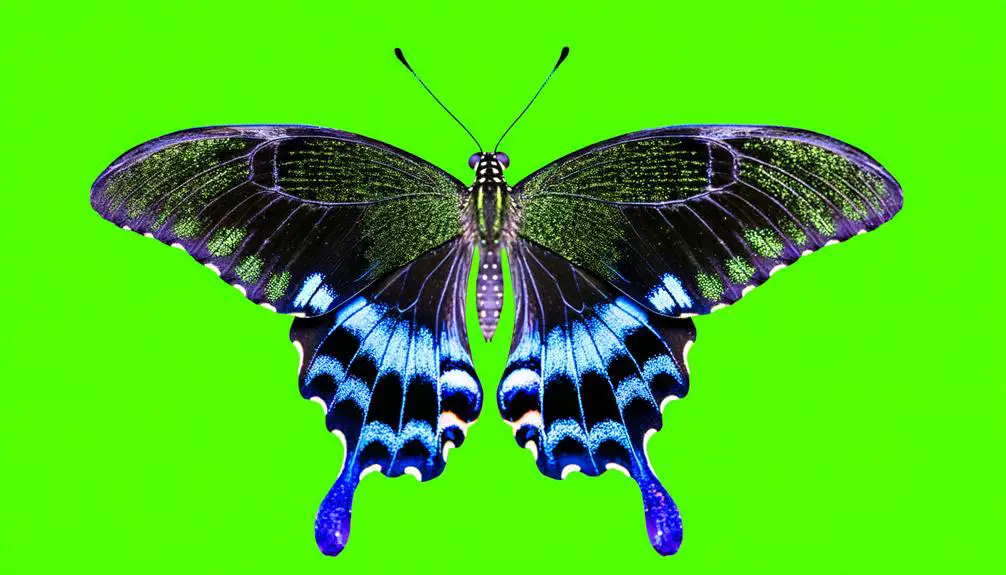
The Swallowtail butterfly is distinguished by its large size, vibrant coloration, and the characteristic tail-like extensions on its hindwings. These extensions, reminiscent of a swallow's tail, serve both aerodynamic and protective functions.
The forewings exhibit striking patterns with a combination of black, blue, and occasionally yellow spots, enhancing their visual appeal and aiding in camouflage among flowers. The ventral side reveals a subtler palette, often with intricate markings that deter predators.
The butterfly's robust thorax supports powerful flight muscles, enabling agile maneuvers. Antennae are clubbed, aiding in navigation and sensory perception. Compound eyes provide a wide field of vision, essential for evading threats.
This species' detailed morphology illustrates evolutionary adaptations for survival and aesthetic charm, enchanting observers and researchers alike.
Habitat and Distribution
Occupying diverse ecosystems, Swallowtail butterflies are primarily found in tropical and temperate regions across the globe.
These lepidopterans inhabit a range of environments from rainforests and woodlands to meadows and gardens. Their presence is particularly noted in areas rich in host plants, which are essential for larval development.
The distribution of Swallowtail butterflies is extensive, spanning continents such as North and South America, Africa, Asia, and Europe. Each species has specific habitat preferences; for instance, Papilio polyxenes thrives in open fields with abundant floral resources.
The adaptability of these butterflies to various ecological zones underscores their evolutionary success, allowing them to exploit diverse niches and maintain robust populations despite environmental fluctuations.
Life Cycle Stages
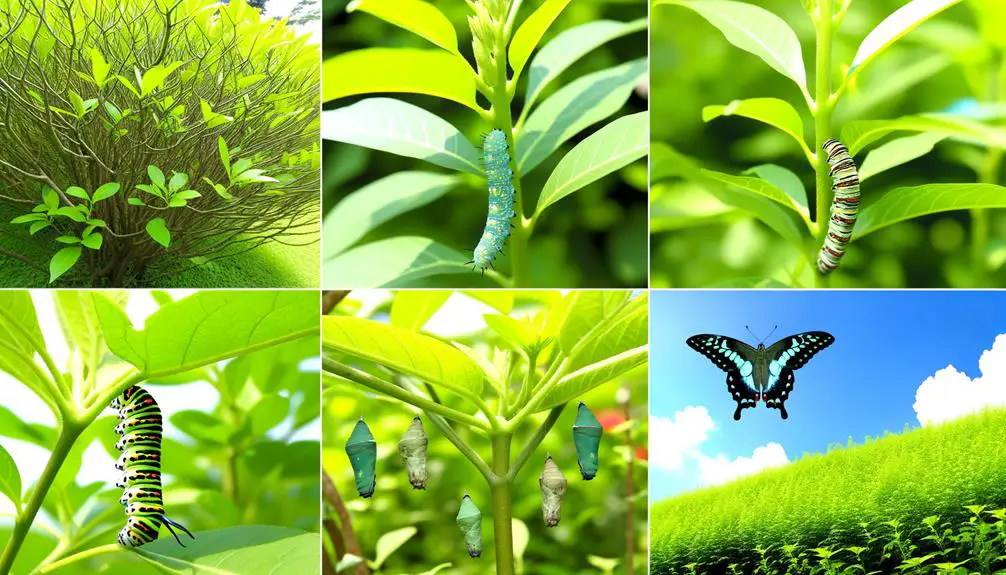
Swallowtail butterflies undergo a complete metamorphosis, progressing through four distinct life cycle stages: egg, larva, pupa, and adult.
Eggs are strategically laid on host plants, ensuring immediate access to food upon hatching.
The larval stage, or caterpillar, exhibits rapid growth through successive molts, shedding its exoskeleton to accommodate its increasing size. This stage is critical for nutrient accumulation.
The pupa, or chrysalis, serves as a transformative phase where the caterpillar undergoes significant morphological changes. Encased in a protective shell, the pupa reorganizes its internal structures to emerge as an adult butterfly.
The adult stage is characterized by maturity in reproductive capabilities and the exhibition of striking black and blue wing patterns, essential for mate attraction and species identification.
Feeding and Diet
Feeding primarily on nectar, swallowtail butterflies exhibit a preference for flowers with ample nectar production and accessible floral structures. These butterflies utilize their elongated proboscis to extract nectar efficiently.
Observations indicate specific floral choices:
- Milkweed (Asclepias spp.): Offers abundant nectar and easy access due to its large, clustered flowers.
- Joe-Pye Weed (Eutrochium spp.): Its composite flower heads provide multiple feeding sites, optimizing nectar intake.
- Thistles (Cirsium spp.): Despite their spiny exteriors, these flowers are rich in nectar and attract various swallowtail species.
Swallowtails' selective feeding habits underscore their ecological role as pollinators, ensuring successful cross-pollination of these plant species.
This mutualistic relationship highlights the intricate balance within ecosystems, fostering both floral and butterfly population sustainability.
Migration Patterns
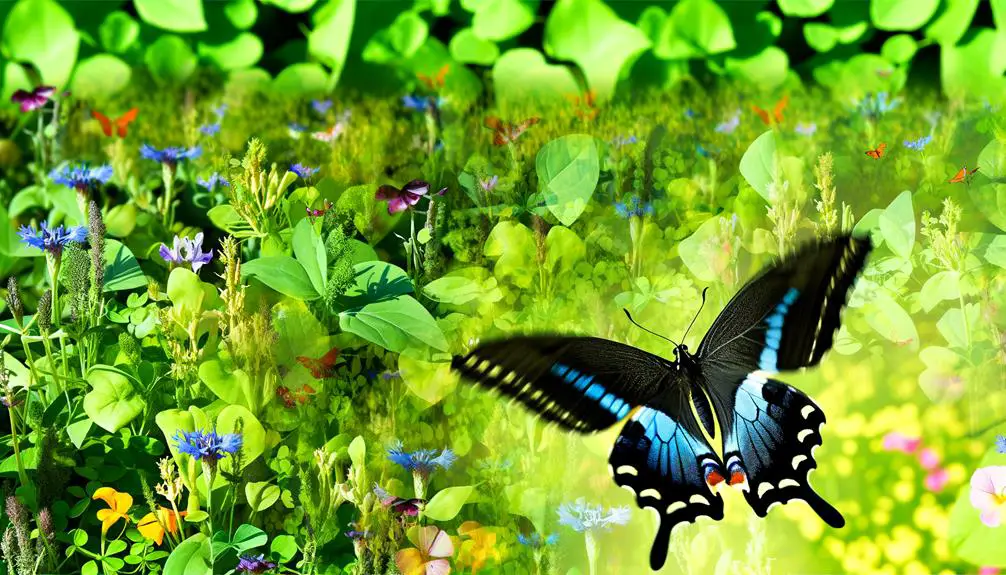
Swallowtail butterflies exhibit intricate migration patterns characterized by distinct seasonal movement routes that are heavily influenced by climatic conditions.
These routes are often dictated by temperature fluctuations and precipitation, which subsequently determine the butterflies' habitat destination preferences.
Understanding these factors is vital for conservation efforts and predicting future migration trends amidst changing global climates.
Seasonal Movement Routes
Tracking the seasonal movement routes of the Swallowtail butterfly reveals intricate patterns of migration influenced by climatic conditions and habitat availability.
These butterflies exhibit significant migration behaviors that are meticulously documented through scientific analysis. Their journeys are characterized by:
- Elevation Migration: Swallowtails often move to higher elevations in warmer months seeking cooler temperatures and abundant floral resources.
- Latitudinal Migration: In response to seasonal temperature fluctuations, Swallowtails migrate northward in spring and southward in autumn.
- Microhabitat Shifts: Within localized regions, Swallowtails frequently shift between microhabitats to exploit seasonal changes in nectar sources and breeding sites.
Such detailed observations underscore the complexity of their migration, reflecting a sophisticated adaptation to environmental variables.
These migratory routes are essential for their survival and reproductive success.
Climate Influence Factors
Climate variability greatly impacts the migratory patterns of the Swallowtail butterfly, dictating their movement through fluctuating temperatures, precipitation levels, and changing seasonal cycles. These environmental factors influence both the timing and pathways of migration, necessitating adaptability.
For instance, warmer temperatures can trigger earlier migrations, while altered precipitation patterns may affect the availability of nectar sources, vital for sustenance during long journeys. Seasonal shifts, such as delayed springs or extended autumns, can disorient established routes, requiring Swallowtails to recalibrate their navigational strategies.
Scientific analysis reveals that these butterflies possess an innate ability to sense climatic cues, ensuring survival despite unpredictable environmental changes. Understanding these patterns is essential for conservation efforts, particularly as climate change continues to pose significant challenges.
Habitat Destination Preferences
Understanding the habitat destination preferences of migratory Swallowtail butterflies involves examining the specific environmental factors and ecological niches that attract these insects during their seasonal movements.
Swallowtails exhibit an intricate relationship with their habitats, driven by their need for ideal conditions for feeding, mating, and laying eggs.
Key factors influencing their migration patterns include:
- Temperature and Humidity: Swallowtails prefer temperate climates with moderate humidity, which support their physiological needs and lifecycle stages.
- Floral Availability: The presence of nectar-rich flowers is vital for their sustenance and energy during long migrations.
- Host Plants: Specific larval host plants are essential for laying eggs and caterpillar development, influencing destination choices.
These elements collectively determine the migratory routes and seasonal habitats preferred by Swallowtail butterflies.
Role in Pollination
Swallowtail butterflies are essential pollinators for a diverse array of flora, contributing considerably to the reproductive success of many plant species.
Their attraction to specific plants, often those with tubular flowers, facilitates targeted pollination, enhancing the genetic diversity of ecosystems.
Through their feeding behavior, which involves the transfer of pollen from one bloom to another, these butterflies play a vital role in maintaining ecological balance and biodiversity.
Essential Pollinators for Flora
As essential pollinators, swallowtail butterflies play a crucial role in the reproductive success of numerous flowering plants, facilitating the transfer of pollen between blossoms. Their intricate flight patterns and unique proboscis structure enable them to access nectar from a diverse array of floral species. This interaction not only supports biodiversity but also enhances genetic variation among plant populations.
The significance of swallowtail butterflies in pollination can be summarized through three key aspects:
- Efficiency: Their frequent visits to flowers guarantee effective pollen transfer, enhancing plant fertilization rates.
- Diversity: Their ability to pollinate a wide range of plants supports various ecosystems.
- Adaptation: Their evolutionary adaptations, such as wing shape and feeding behavior, optimize their role as pollinators.
Thus, swallowtail butterflies are indispensable to ecological balance.
Attraction to Specific Plants
Certain floral species exhibit specific traits that attract swallowtail butterflies, thereby promoting targeted pollination.
These butterflies are drawn to flowers that offer high nectar rewards and possess vivid coloration, particularly in the blue and yellow spectrum.
The presence of open, tubular-shaped blossoms allows for easy access to nectar, catering to the swallowtail's proboscis.
Additionally, the production of specific volatile organic compounds acts as olfactory cues, guiding these pollinators to their preferred flora.
Host plants such as Aristolochia and Lantana species are particularly attractive, owing to their nutrient-rich nectar and strategic flower morphology.
This selective attraction guarantees effective pollination, promoting genetic diversity and the propagation of both plant and butterfly species within their ecosystems.
Pollination Mechanism and Behavior
Despite their delicate appearance, swallowtail butterflies engage in a highly efficient pollination mechanism that guarantees the transfer of pollen between flowers, thereby facilitating cross-pollination and genetic diversity. Their long proboscis allows them to access nectar from deep within blossoms, ensuring contact with reproductive structures.
Through meticulous observation, three key behaviors have been identified:
- Nectar Foraging: Swallowtails exhibit methodical foraging habits, visiting multiple flowers in succession, which enhances pollen distribution.
- Flower Fidelity: They show a preference for specific floral species during each feeding bout, promoting effective pollination within those species.
- Diurnal Activity: Active primarily during the day, swallowtails exploit peak floral nectar availability, optimizing their role in pollination.
Their intrinsic behaviors underscore their essential role in maintaining ecosystem biodiversity.
Conservation Efforts

Conservation efforts for the Swallowtail butterfly primarily focus on habitat preservation, restoration, and mitigating the impacts of climate change.
Key strategies include safeguarding critical habitats from urbanization and agricultural encroachment, as well as reestablishing native flora that supports larval and adult stages.
Detailed monitoring of population dynamics and migration patterns informs adaptive management practices.
Reducing pesticide use and promoting organic farming methods lessen chemical threats.
Addressing climate change involves enhancing habitat connectivity to facilitate range shifts and genetic diversity.
Public education campaigns foster community engagement and support for conservation initiatives.
Scientific collaboration guarantees data-driven decision-making, optimizing resource allocation and policy development.
These concerted efforts aim to secure the Swallowtail's survival and ecological contributions.
Conclusion
The swallowtail black and blue butterfly, with its vibrant coloration and important ecological role, highlights the intricate balance within ecosystems. Its striking appearance serves as a natural deterrent to predators, while also attracting pollinators that contribute to plant reproduction. Similar to the black and white swallowtail, this butterfly plays a crucial role in maintaining biodiversity by aiding in pollination. By fluttering from flower to flower, it helps sustain various plant species, reinforcing the delicate harmony of its habitat.
Remarkably, studies indicate that these butterflies can pollinate up to 30 different plant species, underscoring their fundamental role in biodiversity maintenance.
Conservation efforts are essential to preserve their habitats, as habitat loss poses a significant threat to their populations.
Protecting these butterflies guarantees the continuation of their crucial contributions to pollination and ecosystem health.



